Top Related Projects
📊 Interactive JavaScript Charts built on SVG
Simple HTML5 Charts using the <canvas> tag
Open-source JavaScript charting library behind Plotly and Dash
Highcharts JS, the JavaScript charting framework
Bring data to life with SVG, Canvas and HTML. :bar_chart::chart_with_upwards_trend::tada:
Generation of diagrams like flowcharts or sequence diagrams from text in a similar manner as markdown
Quick Overview
Mini Graph Card is a customizable graph card for Home Assistant's Lovelace UI. It allows users to visualize entity history data in a compact and visually appealing way, supporting various graph types, multiple entities, and extensive customization options.
Pros
- Highly customizable with numerous options for appearance and behavior
- Supports multiple graph types (line, bar, area)
- Ability to display multiple entities on a single graph
- Responsive design that adapts to different screen sizes
Cons
- Requires some familiarity with YAML configuration
- Limited to displaying historical data from Home Assistant entities
- May have performance issues with large datasets or many graphs on a single page
- Some advanced features may require additional setup or custom JavaScript
Code Examples
- Basic configuration for a single entity:
type: custom:mini-graph-card
entity: sensor.temperature
- Configuring multiple entities with custom colors:
type: custom:mini-graph-card
entities:
- entity: sensor.temperature
color: red
- entity: sensor.humidity
color: blue
- Advanced configuration with custom graph type and styling:
type: custom:mini-graph-card
entities:
- sensor.power_consumption
aggregate_func: max
group_by: hour
hour24: true
line_width: 2
height: 150
show:
graph: bar
fill: true
points: hover
color_thresholds:
- value: 1000
color: yellow
- value: 2000
color: red
Getting Started
- Install HACS (Home Assistant Community Store) if not already installed.
- Add the following custom repository in HACS:
https://github.com/kalkih/mini-graph-card - Install the "mini-graph-card" from HACS.
- Add the following to your
configuration.yaml:
lovelace:
resources:
- url: /hacsfiles/mini-graph-card/mini-graph-card-bundle.js
type: module
- Restart Home Assistant.
- Add a mini-graph-card to your Lovelace UI using the examples provided above.
Competitor Comparisons
📊 Interactive JavaScript Charts built on SVG
Pros of ApexCharts.js
- More comprehensive and feature-rich charting library
- Supports a wider variety of chart types
- Better documentation and community support
Cons of ApexCharts.js
- Larger file size and potentially heavier performance impact
- Steeper learning curve due to more complex API
- May be overkill for simple graph requirements
Code Comparison
mini-graph-card:
this.graph = this._card.querySelector('svg');
this.line = this.graph.querySelector('path');
this.bar = this.graph.querySelector('g');
this.updated = this.line || this.bar;
ApexCharts.js:
var options = {
chart: { type: 'line' },
series: [{ data: [30, 40, 35, 50, 49, 60, 70] }],
xaxis: { categories: [1991, 1992, 1993, 1994, 1995, 1996, 1997] }
};
var chart = new ApexCharts(document.querySelector("#chart"), options);
chart.render();
mini-graph-card is specifically designed for Home Assistant dashboards, offering a simpler API and lighter weight for basic graph needs. ApexCharts.js is a more versatile and powerful charting library suitable for a wide range of applications but may be excessive for simple use cases.
Simple HTML5 Charts using the <canvas> tag
Pros of Chart.js
- More versatile and feature-rich, supporting a wide range of chart types
- Extensive documentation and large community support
- Highly customizable with numerous configuration options
Cons of Chart.js
- Larger file size and potentially higher performance overhead
- Steeper learning curve due to its extensive API and options
- May be overkill for simple graph requirements
Code Comparison
mini-graph-card:
type: custom:mini-graph-card
entities:
- sensor.temperature
- sensor.humidity
hours_to_show: 24
points_per_hour: 2
Chart.js:
new Chart(ctx, {
type: 'line',
data: {
labels: ['Jan', 'Feb', 'Mar', 'Apr', 'May'],
datasets: [{
label: 'Temperature',
data: [12, 19, 3, 5, 2]
}]
}
});
Summary
Mini-graph-card is a lightweight, Home Assistant-specific solution for simple graphs, while Chart.js is a more powerful, general-purpose charting library. Mini-graph-card excels in ease of use and integration with Home Assistant, whereas Chart.js offers greater flexibility and features for complex data visualization needs across various platforms.
Open-source JavaScript charting library behind Plotly and Dash
Pros of plotly.js
- More comprehensive and feature-rich charting library
- Supports a wide range of chart types and customization options
- Suitable for complex data visualization needs across various domains
Cons of plotly.js
- Larger file size and potentially higher performance overhead
- Steeper learning curve due to its extensive API and options
- May be overkill for simple graph requirements
Code Comparison
mini-graph-card:
type: custom:mini-graph-card
entities:
- sensor.temperature
- sensor.humidity
hours_to_show: 24
points_per_hour: 2
plotly.js:
var trace = {
x: [1, 2, 3, 4],
y: [10, 15, 13, 17],
type: 'scatter'
};
var data = [trace];
Plotly.newPlot('myDiv', data);
Summary
mini-graph-card is a lightweight, Home Assistant-specific solution for creating simple graphs, while plotly.js is a more powerful and versatile charting library suitable for various web applications. mini-graph-card excels in ease of use and integration with Home Assistant, whereas plotly.js offers greater flexibility and advanced features for complex data visualization needs.
Highcharts JS, the JavaScript charting framework
Pros of Highcharts
- More comprehensive and feature-rich charting library
- Supports a wider range of chart types and customization options
- Better documentation and community support
Cons of Highcharts
- Larger file size and potentially heavier performance impact
- Commercial license required for most use cases
- Steeper learning curve due to its extensive API
Code Comparison
mini-graph-card:
this.graph = this._card.querySelector('svg');
this.graph.innerHTML = `
<defs>
<linearGradient id="gradient" x1="0%" y1="0%" x2="100%" y2="0%">
<stop offset="0%" stop-color="var(--gradient-color-1)" />
<stop offset="100%" stop-color="var(--gradient-color-2)" />
</linearGradient>
</defs>
`;
Highcharts:
Highcharts.chart('container', {
chart: {
type: 'line'
},
title: {
text: 'Monthly Average Temperature'
},
series: [{
data: [7.0, 6.9, 9.5, 14.5, 18.2, 21.5, 25.2]
}]
});
mini-graph-card is a lightweight, custom solution for creating simple graphs in Home Assistant, while Highcharts is a full-featured charting library suitable for various applications. mini-graph-card focuses on simplicity and integration with Home Assistant, whereas Highcharts offers more flexibility and advanced features at the cost of complexity and licensing requirements.
Bring data to life with SVG, Canvas and HTML. :bar_chart::chart_with_upwards_trend::tada:
Pros of d3
- Highly flexible and powerful data visualization library
- Extensive documentation and large community support
- Wide range of chart types and customization options
Cons of d3
- Steeper learning curve for beginners
- Requires more code to create basic visualizations
- Heavier library size compared to mini-graph-card
Code Comparison
mini-graph-card:
type: custom:mini-graph-card
entities:
- sensor.temperature
- sensor.humidity
hours_to_show: 24
points_per_hour: 2
d3:
const svg = d3.select("body").append("svg")
.attr("width", 960)
.attr("height", 500);
svg.selectAll("circle")
.data(data)
.enter().append("circle")
.attr("cx", d => d.x)
.attr("cy", d => d.y)
.attr("r", 5);
Summary
mini-graph-card is a specialized solution for Home Assistant dashboards, offering easy integration and quick setup for basic graphs. d3, on the other hand, is a comprehensive data visualization library with broader applications and more advanced features. While mini-graph-card excels in simplicity for Home Assistant users, d3 provides greater flexibility and power for complex visualizations across various platforms.
Generation of diagrams like flowcharts or sequence diagrams from text in a similar manner as markdown
Pros of mermaid
- More versatile, capable of creating various types of diagrams (flowcharts, sequence diagrams, Gantt charts, etc.)
- Wider adoption and larger community support
- Can be used in multiple environments (web, Markdown, documentation)
Cons of mermaid
- Steeper learning curve due to its more complex syntax
- Requires more setup and configuration for integration
- May be overkill for simple graphing needs
Code comparison
mini-graph-card:
type: custom:mini-graph-card
entities:
- sensor.temperature
- sensor.humidity
hours_to_show: 24
points_per_hour: 2
mermaid:
graph TD
A[Start] --> B{Is it?}
B -->|Yes| C[OK]
B -->|No| D[End]
Summary
mini-graph-card is specifically designed for Home Assistant and focuses on creating simple, customizable graphs. It's easier to use for basic graphing needs but limited in scope. mermaid, on the other hand, offers a wide range of diagramming capabilities and can be used in various contexts. However, it requires more effort to learn and implement, especially for simple graphs. The choice between the two depends on the specific use case and the complexity of the visualizations required.
Convert  designs to code with AI
designs to code with AI

Introducing Visual Copilot: A new AI model to turn Figma designs to high quality code using your components.
Try Visual CopilotREADME
Lovelace Mini Graph Card
A minimalistic and customizable graph card for Home Assistant Lovelace UI.
The card works with entities from within the sensor & binary_sensor domain and displays the sensors current state as well as a line graph representation of the history.
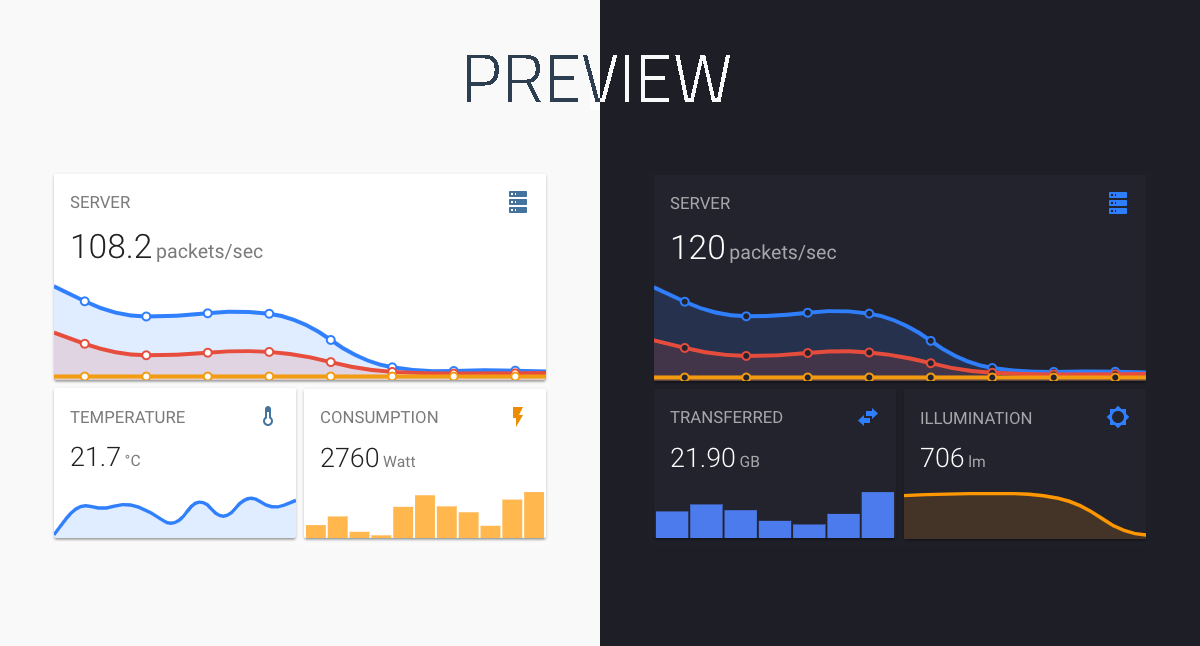
Install
HACS (recommended)
This card is available in HACS (Home Assistant Community Store).
HACS is a third party community store and is not included in Home Assistant out of the box.
Manual install
-
Download and copy
mini-graph-card-bundle.jsfrom the latest release into yourconfig/wwwdirectory. -
Add the resource reference as decribed below.
CLI install
-
Move into your
config/wwwdirectory. -
Grab
mini-graph-card-bundle.js:
$Â wget https://github.com/kalkih/mini-graph-card/releases/download/v0.13.0/mini-graph-card-bundle.js
- Add the resource reference as decribed below.
Add resource reference
If you configure Lovelace via YAML, add a reference to mini-graph-card-bundle.js inside your configuration.yaml:
resources:
- url: /local/mini-graph-card-bundle.js?v=0.13.0
type: module
Else, if you prefer the graphical editor, use the menu to add the resource:
- Make sure, advanced mode is enabled in your user profile (click on your user name to get there)
- Navigate to Configuration -> Lovelace Dashboards -> Resources Tab. Hit orange (+) icon
- Enter URL
/local/mini-graph-card-bundle.jsand select type "JavaScript Module". (Use/hacsfiles/mini-graph-card/mini-graph-card-bundle.jsand select "JavaScript Module" for HACS install) - Restart Home Assistant.
Updating
If you have a version older than v0.0.8 installed, please delete the current files and follow the installation instructions again.
-
Find your
mini-graph-card-bundle.jsfile inconfig/wwwor wherever you ended up storing it. -
Replace the local file with the latest one attached in the latest release.
-
Add the new version number to the end of the cards reference url in your
ui-lovelace.yamllike below:
resources:
- url: /local/mini-graph-card-bundle.js?v=0.13.0
type: module
You may need to empty the browsers cache if you have problems loading the updated card.
Using the card
We recommend looking at the Example usage section to understand the basics to configure this card. (also) pay attention to the required options mentioned below.
Options
Card options
| Name | Type | Default | Since | Description |
|---|---|---|---|---|
| type (required) | string | v0.0.1 | custom:mini-graph-card. | |
| entities (required) | list | v0.2.0 | One or more sensor entities in a list, see entities object for additional entity options. | |
| icon | string | v0.0.1 | Set a custom icon from any of the available mdi icons. | |
| icon_image | string | v0.12.0 | Override icon with an image url | |
| name | string | v0.0.1 | Set a custom name which is displayed beside the icon. | |
| unit | string | v0.0.1 | Set a custom unit of measurement ('' value for an empty unit). | |
| tap_action | action object | v0.7.0 | Action on click/tap. | |
| group | boolean | false | v0.2.0 | Disable paddings and box-shadow, useful when nesting the card. |
| hours_to_show | integer | 24 | v0.0.2 | Specify how many hours of history the graph should present. |
| points_per_hour | number | 0.5 | v0.2.0 | Specify amount of data points the graph should display for each hour, (basically the detail/accuracy/smoothing of the graph). |
| aggregate_func | string | avg | v0.8.0 | Specify aggregate function used to calculate point/bar in the graph. |
| group_by | string | interval | v0.8.0 | Specify type of grouping of data, dynamic interval, date or hour. |
| update_interval | number | v0.4.0 | Specify a custom update interval of the history data (in seconds), instead of on every state change. | |
| cache | boolean | true | v0.9.0 | Enable/disable local caching of history data. |
| show | list | v0.2.0 | List of UI elements to display/hide, for available items see available show options. | |
| animate | boolean | false | v0.2.0 | Add a reveal animation to the graph. |
| height | number | 150 | v0.0.1 | Set a custom height of the line graph. |
| bar_spacing | number | 4 | v0.9.0 | Set the spacing between bars in bar graph. |
| line_width | number | 5 | v0.0.1 | Set the thickness of the line. |
| line_color | string/list | var(--accent-color) | v0.0.1 | Set a custom color for the graph line, provide a list of colors for multiple graph entries. |
| color_thresholds | list | v0.2.3 | Set thresholds for dynamic graph colors, see Line color object. | |
| color_thresholds_transition | string | smooth | v0.4.3 | Color threshold transition, smooth or hard. |
| decimals | integer | v0.0.9 | Specify the exact number of decimals to show for states. | |
| hour24 | boolean | false | v0.2.1 | Set to true to display times in 24-hour format. |
| font_size | number | 100 | v0.0.3 | Adjust the font size of the state, as percentage of the original size. |
| font_size_header | number | 14 | v0.3.1 | Adjust the font size of the header, size in pixels. |
| align_header | string | default | v0.2.0 | Set the alignment of the header, left, right, center or default. |
| align_icon | string | right | v0.2.0 | Set the alignment of the icon, left, right or state. |
| align_state | string | left | v0.2.0 | Set the alignment of the current state, left, right or center. |
| lower_bound | number or string | v0.2.3 | Set a fixed lower bound for the graph Y-axis. String value starting with ~ (e.g. ~50) specifies soft bound. | |
| upper_bound | number or string | v0.2.3 | Set a fixed upper bound for the graph Y-axis. String value starting with ~ (e.g. ~50) specifies soft bound. | |
| min_bound_range | number | v0.x.x | Applied after everything, makes sure there's a minimum range that the Y-axis will have. Useful for not making small changes look large because of scale. | |
| lower_bound_secondary | number or string | v0.5.0 | Set a fixed lower bound for the graph secondary Y-axis. String value starting with ~ (e.g. ~50) specifies soft bound. | |
| upper_bound_secondary | number or string | v0.5.0 | Set a fixed upper bound for the graph secondary Y-axis. String value starting with ~ (e.g. ~50) specifies soft bound. | |
| min_bound_range_secondary | number | v0.x.x | Applied after everything, makes sure there's a minimum range that the secondary Y-axis will have. Useful for not making small changes look large because of scale. | |
| smoothing | boolean | true | v0.8.0 | Whether to make graph line smooth. |
| state_map | state map object | v0.8.0 | List of entity states to convert (order matters as position becomes a value on the graph). | |
| value_factor | number | 0 | v0.9.4 | Scale value by order of magnitude (e.g. convert Watts to kilo Watts), use negative value to scale down. |
| logarithmic | boolean | false | v0.10.0 | Use a Logarithmic scale for the graph |
Entities object
Entities may be listed directly (as per sensor.temperature in the example below), or defined using
properties of the Entity object detailed in the following table (as per sensor.pressure in the example below).
| Name | Type | Default | Description |
|---|---|---|---|
| entity (required) | string | Entity id of the sensor. | |
| attribute | string | Retrieves an attribute or sub-attribute (attr1.attr2...) instead of the state | |
| name | string | Set a custom display name, defaults to entity's friendly_name. | |
| color | string | Set a custom color, overrides all other color options including thresholds. | |
| unit | string | Set a custom unit of measurement, overrides unit set in base config ('' value for an empty unit). | |
| aggregate_func | string | Override for aggregate function used to calculate point on the graph, avg, median, min, max, first, last, sum. | |
| show_state | boolean | Display the current state. | |
| show_legend_state | boolean | false | Display the current state as part of the legend. |
| show_indicator | boolean | Display a color indicator next to the state, (only when more than two states are visible). | |
| show_graph | boolean | Set to false to completely hide the entity in the graph. | |
| show_line | boolean | Set to false to hide the line. | |
| show_fill | boolean | Set to false to hide the fill. | |
| show_points | boolean | Set to false to hide the points. | |
| show_legend | boolean | Set to false to turn hide from the legend. | |
| state_adaptive_color | boolean | Make the color of the state adapt to the entity color. | |
| y_axis | string | If 'secondary', displays using the secondary y-axis on the right. | |
| fixed_value | boolean | Set to true to graph the entity's current state as a fixed value instead of graphing its state history. | |
| smoothing | boolean | Override for a flag indicating whether to make graph line smooth. |
entities:
- sensor.temperature
- entity: sensor.pressure
name: Pressure
show_state: true
- sensor.humidity
Available show options
All properties are optional.
| Name | Default | Options | Description |
|---|---|---|---|
| name | true | true / false | Display name. |
| icon | true | true / false | Display icon. |
| state | true | true / false / last | Display current state. last will show the last graph point's value. |
| graph | line | line / bar / false | Display option for the graph. If set to bar a maximum of 96 bars will be displayed. |
| fill | true | true / false / fade | Display the line graph fill. |
| points | hover | true / false / hover | Display graph data points. |
| legend | true | true / false | Display the graph legend (only shown when graph contains multiple entities). |
| average | false | true / false | Display average information. |
| extrema | false | true / false | Display max/min information. |
| labels | hover | true / false / hover | Display Y-axis labels. |
| labels_secondary | hover | true / false / hover | Display secondary Y-axis labels. |
| name_adaptive_color | false | true / false | Make the name color adapt with the primary entity color. |
| icon_adaptive_color | false | true / false | Make the icon color adapt with the primary entity color. |
| loading_indicator | true | true / false | Show loading indicator while attempting to retrieve a history. |
Line color object
See dynamic line color for example usage.
| Name | Type | Default | Description |
|---|---|---|---|
| value (required except in interpolation (see below)) | number | The threshold for the color stop. | |
| color (required) | string | Color in 6 digit hex format (e.g. #008080). |
Line color interpolation of stop values
As long as the first and last threshold stops have value properties, intermediate stops can exclude value; they will be interpolated linearly. For example, given stops like:
color_thresholds:
- value: 0
color: "#ff0000"
- color: "#ffff00"
- color: "#00ff00"
- value: 4
color: "#0000ff"
The values will be interpolated as:
color_thresholds:
- value: 0
color: "#ff0000"
- value: 1.333333
color: "#ffff00"
- value: 2.666667
color: "#00ff00"
- value: 4
color: "#0000ff"
The example above will result in the following colors of the graph: if value is
- between
0(including this value) and1.33333, the color is#ff0000, - between
1.33333(including this value) and2.666667, the color is#ffff00, - between
2.666667(including this value) and4, the color is#00ff00, - equal to or more than
4, the color is#0000ff.
As a shorthand, you can just use a color string for the stops that you want interpolated:
- value: 0
color: "#ff0000"
- "#ffff00"
- "#00ff00"
- value: 4
color: "#0000ff"
Action object options
| Name | Type | Default | Options | Description |
|---|---|---|---|---|
| action | string | more-info | more-info / navigate / call-service / url / none | Action to perform. |
| entity | string | Any entity id | Override default entity of more-info, when action is defined as more-info. | |
| service | string | Any service | Service to call (e.g. media_player.toggle) when action is defined as call-service. | |
| service_data | object | Any service data | Service data to include with the service call (e.g. entity_id: media_player.office). | |
| navigation_path | string | Any path | Path to navigate to (e.g. /lovelace/0/) when action is defined as navigate. | |
| url | string | Any URL | URL to open when action is defined as url. |
State map object
| Name | Type | Default | Description |
|---|---|---|---|
| value (required) | string | Value to convert. | |
| label | string | same as value | String to show as label (if the value is not precise). |
Aggregate functions
Recorded values are grouped in time buckets which are determined by group_by, points_per_hour configuration.
These buckets are converted later to single point/bar on the graph. Aggregate function defines the methods of that conversion.
| Name | Since | Description |
|---|---|---|
avg | v0.8.0 | Average |
median | v0.11.0 | Median |
min | v0.8.0 | Minimum - lowest value |
max | v0.8.0 | Maximum - largest value |
first | v0.9.0 | |
last | v0.9.0 | |
sum | v0.9.2 | |
delta | v0.9.4 | Calculates difference between max and min value |
diff | v0.11.0 | Calculates difference between first and last value |
Theme variables
The following theme variables can be set in your HA theme to customize the appearance of the card.
| Name | Default | Description |
|---|---|---|
| mcg-title-letter-spacing | Letter spacing of the card title (name option). | |
| mcg-title-font-weight | 500 | Font weight of the card title. |
Example usage
Single entity card
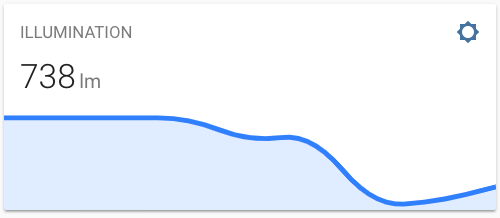
type: custom:mini-graph-card
entities:
- sensor.illumination
Alternative style
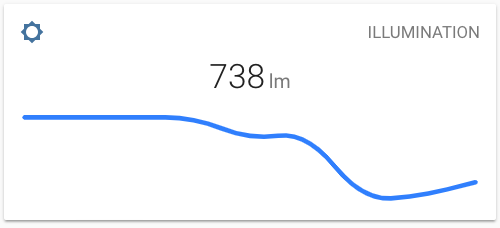
type: custom:mini-graph-card
entities:
- sensor.illumination
align_icon: left
align_state: center
show:
fill: false
Multiple entities card
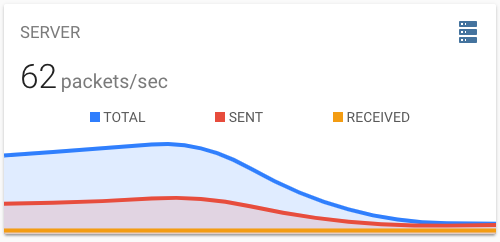
type: custom:mini-graph-card
name: SERVER
icon: mdi:server
entities:
- entity: sensor.server_total
name: TOTAL
- sensor.server_sent
- sensor.server_received
Bar chart card
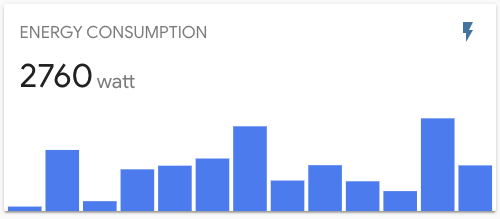
type: custom:mini-graph-card
entities:
- entity: sensor.energy_consumption
name: ENERGY CONSUMPTION
show:
graph: bar
Show data from the past week
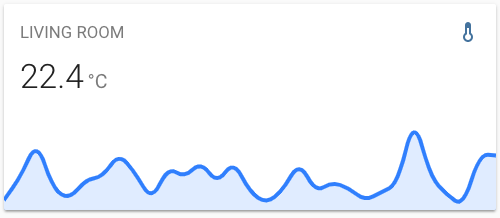
Use the hours_to_show option to specify how many hours of history the graph should represent.
Use the points_per_hour option to specify the accuracy/detail of the graph.
type: custom:mini-graph-card
entities:
- sensor.living_room_temp
name: LIVING ROOM
hours_to_show: 168
points_per_hour: 0.25
Graph only card
Use the show option to show/hide UI elements.
type: custom:mini-graph-card
entities:
- sensor.humidity
show:
icon: false
name: false
state: false
Horizontally stacked cards
You can stack cards horizontally by using one or more horizontal-stack(s).

type: horizontal-stack
cards:
- type: custom:mini-graph-card
entities:
- sensor.humidity
line_color: blue
line_width: 8
font_size: 75
- type: custom:mini-graph-card
entities:
- sensor.illumination
line_color: '#e74c3c'
line_width: 8
font_size: 75
- type: custom:mini-graph-card
entities:
- sensor.temperature
line_color: var(--accent-color)
line_width: 8
font_size: 75
Dynamic line color
Have the graph change line color dynamically.
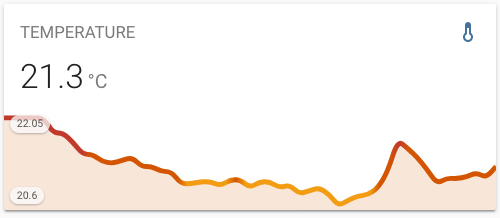
type: custom:mini-graph-card
entities:
- sensor.sensor_temperature
show:
labels: true
color_thresholds:
- value: 20
color: "#f39c12"
- value: 21
color: "#d35400"
- value: 21.5
color: "#c0392b"
Alternate y-axis
Have one or more series plot on a separate y-axis, which appears on the right side of the graph. This example also shows turning off the line, points and legend.
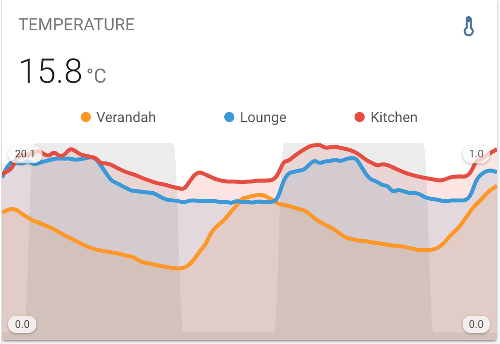
type: custom:mini-graph-card
entities:
- entity: sensor.verandah
name: Verandah
- entity: sensor.lounge
name: Lounge
- entity: sensor.kitchen
name: Kitchen
- color: gray
entity: input_number.nighttime
name: Night
show_line: false
show_points: false
show_legend: false
y_axis: secondary
show:
labels: true
labels_secondary: true
Grouping by date
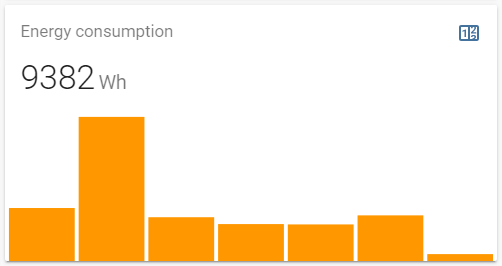
You can group values by date, this way you can visualize for example daily energy consumption.
type: custom:mini-graph-card
entities:
- entity: sensor.energy_daily
name: Energy consumption
hours_to_show: 168
aggregate_func: max
group_by: date
show:
graph: bar
Data aggregation functions
You can decide how values are aggregated for points on graph. Example how to display min, max, avg temperature per day from last week.
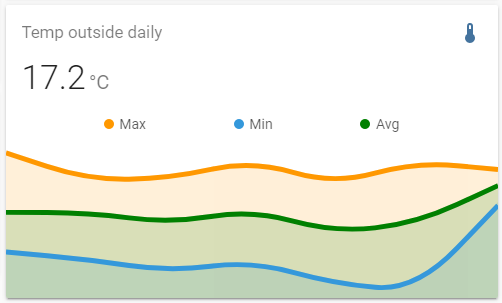
type: custom:mini-graph-card
entities:
- entity: sensor.outside_temp
aggregate_func: max
name: Max
color: "#e74c3c"
- entity: sensor.outside_temp
aggregate_func: min
name: Min
- entity: sensor.outside_temp
aggregate_func: avg
name: Avg
color: green
name: Temp outside daily (last week)
hours_to_show: 168
group_by: date
Non-numeric sensor states
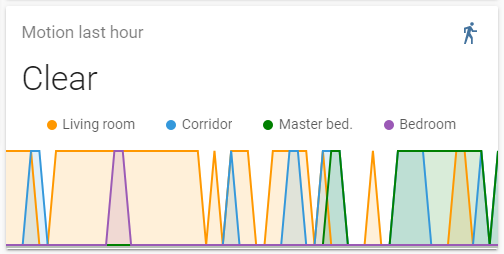
You can render non-numeric states by providing state_map config. For example this way you can show data coming from binary sensors.
type: custom:mini-graph-card
entities:
- entity: binary_sensor.living_room_motion
name: Living room
- entity: binary_sensor.corridor_motion
name: Corridor
- entity: binary_sensor.master_bed_motion
name: Master bed.
color: green
- entity: binary_sensor.bedroom_motion
name: Bedroom
name: Motion last hour
hours_to_show: 1
points_per_hour: 60
update_interval: 30
aggregate_func: max
line_width: 2
smoothing: false
state_map:
- value: "off"
label: Clear
- value: "on"
label: Detected
Showing additional info on the card
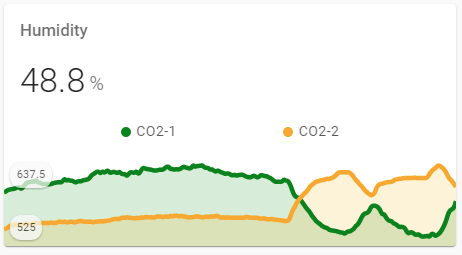
It is possible to show a state without displaying a graph for a sensor. Imagine there are two CO-2 sensors & one humidity sensor; graphs are displayed for the CO-2 only, and the humidity is shown as a state only.
type: custom:mini-graph-card
entities:
- entity: sensor.xiaomi_cg_1_humidity
show_state: true
show_graph: false
- entity: sensor.xiaomi_cg_1_co2
color: green
show_state: false
name: CO2-1
- entity: sensor.xiaomi_cg_2_co2
color: orange
show_state: false
name: CO2-2
name: Humidity
hours_to_show: 4
points_per_hour: 60
show:
name: true
legend: true
icon: false
labels: true
This method may be also used to add a calculated value with it's own aggregate_func option.
Accessing attributes in complex structures
When using the attribute option in the entities object, you can access data in structured attributes, such as dictionaries and lists.
Accessing dictionary attributes
Suppose you have data stored inside a dictionary attribute named dict_attribute
dict_attribute:
value_1: 53
value_2: 64
value_3: 72
Such data should be addressed as dict_attribute.sub_attribute:
type: custom:mini-graph-card
entities:
- entity: sensor.testing_object_data
attribute: dict_attribute.value_1
name: value_1 from dictionary attribute
Accessing list attributes
Suppose you have data stored inside a list attribute named list_attribute:
list_attribute:
- value_1: 67
value_2: 65
value_3: 93
- value_1: 134
value_2: 130
value_3: 186
- value_1: 201
value_2: 195
value_3: 279
Such data should be addressed as list_attribute.index.sub_attribute:
type: custom:mini-graph-card
entities:
- entity: sensor.testing_object_data_list
attribute: list_attribute.0.value_1
name: value_1 from first element of list attribute
Development
- Clone this repository into your
config/wwwfolder using git:
$ git clone https://github.com/kalkih/mini-graph-card.git
- Add a reference to the card in your
ui-lovelace.yaml:
resources:
- url: /local/mini-graph-card/dist/mini-graph-card-bundle.js
type: module
Instructions
Requires nodejs & npm.
- Move into the
mini-graph-cardrepo, checkout the dev branch & install dependencies:
$ cd mini-graph-card && git checkout dev && npm install
-
Make changes to the source code.
-
Build the source by running:
$ npm run build
-
Refresh the browser to see changes.
Make sure cache is cleared or disabled.
-
(Optional) Watch the source and automatically rebuild on save:
$ npm run watch
The new mini-graph-card-bundle.js will be build and ready inside /dist.
Note that the dev branch is the most up-to-date and matches our beta releases.
Please refer to the Contribution Guidelines if you're interested in contributing to the project. (And thanks for considering!)
Getting errors?
Make sure you have javascript_version: latest in your configuration.yaml under frontend:.
Make sure you have the latest versions of mini-graph-card.js & mini-graph-lib.js.
If you have issues after updating the card, try clearing your browser cache.
If you have issues displaying the card in older browsers, try changing type: module to type: js at the card reference in ui-lovelace.yaml.
License
This project is under the MIT license.
Top Related Projects
📊 Interactive JavaScript Charts built on SVG
Simple HTML5 Charts using the <canvas> tag
Open-source JavaScript charting library behind Plotly and Dash
Highcharts JS, the JavaScript charting framework
Bring data to life with SVG, Canvas and HTML. :bar_chart::chart_with_upwards_trend::tada:
Generation of diagrams like flowcharts or sequence diagrams from text in a similar manner as markdown
Convert  designs to code with AI
designs to code with AI

Introducing Visual Copilot: A new AI model to turn Figma designs to high quality code using your components.
Try Visual Copilot